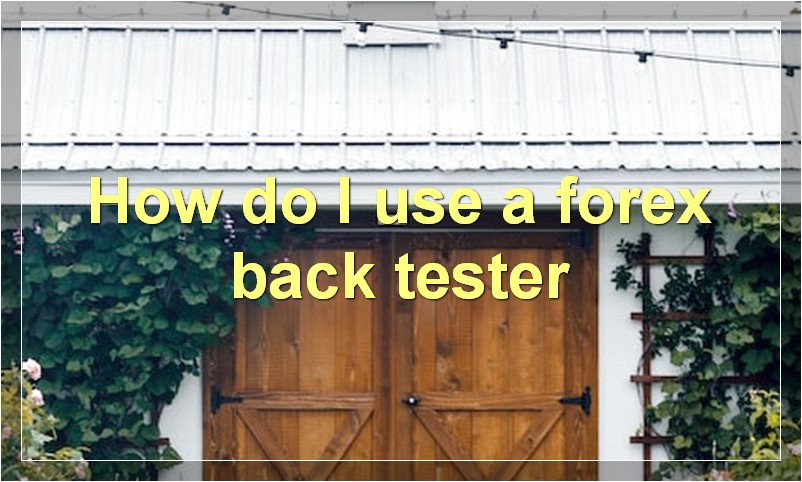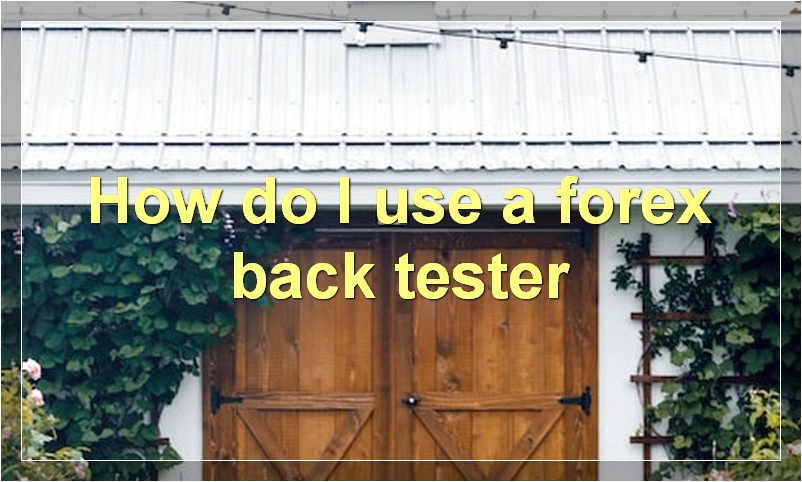Whether you want to start trading Forex or you’re looking to improve your results, backtesting is an essential tool. By testing your trading strategy on historical data, you can gain valuable insights into how your strategy would have performed in different market conditions. In this article, we’ll show you how to get started with Forex backtesting and how you can use it to improve your results.
What is the best forex back tester
Forex backtesting is an essential tool for developing and refining trading strategies. A backtester allows you to test your strategy against historical data to find out how it would have performed in the past.
There are many different forex backtesting software programs available on the market. Some are more user-friendly than others. Some are more expensive than others.
So, what is the best forex back tester?
The answer to this question depends on your individual needs and preferences. If you are new to forex backtesting, you may want to start with a free or low-cost program to get a feel for how it works.
Once you have a better understanding of backtesting, you can decide if you need a more sophisticated program with more features. If you plan on doing a lot of backtesting, you may want to consider a program that offers automated backtesting.
No matter what your level of experience is, there is a forex backtesting program that is right for you. The best way to find the right one is to experiment with different programs and see which one works best for your particular trading style and needs.
How do I use a forex back tester

A forex back tester is a great tool for testing your trading strategy. It allows you to test your system on historical data, so you can see how it would have performed in the past. This can help you to find any potential problems with your system and fix them before you start trading with real money.
To use a forex back tester, first you need to download some historical data. You can get this from your broker or from a website like Dukascopy. Once you have the data, you need to load it into the back tester. Most back testers will allow you to specify which currency pairs you want to test and what time period you want to test over.
Once you have the data loaded, you need to set up your trading rules. This includes things like when to enter and exit trades, what position size to use, and how much risk to take. Once you have your rules set up, you can start the back test. The back tester will then simulate trading according to your rules and show you how your system would have performed.
You can use a forex back tester to test any kind of trading system. Whether you are using technical indicators, fundamental analysis, or a combination of both, a back tester can help you to optimize your system and find any potential problems. If you are serious about trading forex, then a back tester is an essential tool.
What are the benefits of using a forex back tester
Forex backtesters are computer programs that allow traders to test potential trading strategies using historical data. These programs can be used to find out if a particular strategy would have been successful in the past, and can also be used to test different parameters of a strategy to find the optimal set of conditions.
There are many benefits to using a forex back tester. Perhaps the most obvious benefit is that it can save a lot of time and effort compared to manually testing a strategy on historical data. Backtesting can also be used to test a large number of trading strategies very quickly, which is important for finding the best possible strategy.
Another benefit of backtesting is that it can help traders to identify potential issues with their trading strategies before they put any real money at risk. Backtesting can also be used to fine-tune a strategy before launching it live, which can help to improve the chances of success.
How can I improve my forex back testing results
If you want to improve your forex back testing results, here are a few tips:
1. Make sure you are using high-quality data. This means data that is accurate and representative of the real market conditions.
2. Use a robust backtesting platform. This will help you to identify any potential issues with your data or your trading strategy.
3. Test your strategy in multiple timeframes. This will help you to see how your strategy performs in different market conditions.
4. Be patient and consistent with your backtesting. Do not try to rush the process or cut corners. This will only lead to inaccurate results.
What are some common mistakes made when back testing forex strategies
Forex backtesting is the process of testing a trading strategy on historical data to determine how it would have performed in the past. Backtesting can be used to test a wide variety of trading strategies, from simple trend-following systems to complex algorithmic strategies.
However, backtesting is not without its pitfalls. Here are some common mistakes made when backtesting forex strategies:
1. Not accounting for slippage and commissions
Slippage and commissions can have a significant impact on trading results, especially when scalping or day trading. Be sure to factor these costs into your backtesting to get an accurate representation of how the strategy would have performed in real-world conditions.
2. Not using enough data
When backtesting, it’s important to use as much data as possible. This will help ensure that your results are not simply due to chance or market conditions that may no longer exist. Ideally, you should use at least 5 years’ worth of data for your backtesting.
3. Not testing different timeframes
It’s important to test your strategy on different timeframes to see how robust it is. A strategy that works well on a 1-hour chart may not perform as well on a daily or weekly chart. By testing on different timeframes, you can get a better idea of how your strategy will perform in different market conditions.
4. Overfitting your data
Overfitting is a common problem in machine learning and can also occur when backtesting trading strategies. Overfitting occurs when a model is too closely fit to the training data and doesn’t generalize well to new data. This can lead to inaccurate out-of-sample results and false positives. To avoid overfitting, be sure to use cross-validation when backtesting and only use parameters that have been shown to be statistically significant.
How do I know if my forex back testing results are accurate

Forex back testing can be a great way to test your trading strategies before implementing them in the live market. However, it’s important to make sure that your back testing results are accurate before you put any real money on the line. Here are a few things to look for when evaluating your back testing results:
1) Does your strategy perform well in different market conditions? If your strategy only works in one type of market, it may not be as robust as you think. Back test your strategy in a variety of market conditions to see how it holds up.
2) Do your results match up with historical data? If your backtesting results don’t match up with actual historical data, there may be something wrong with your assumptions or your data. Make sure to check for this before moving forward.
3) Are you able to replicate your results? If you can’t replicate your backtesting results, it may be due to randomness or luck. Try running your test again to see if you get the same results.
4) What is the risk/reward ratio of your strategy? A good trading strategy should have a positive risk/reward ratio. This means that for every dollar you risk, you should expect to make more than a dollar in return. If your strategy has a negative risk/reward ratio, you may want to reconsider it.
By following these tips, you can help ensure that your backtesting results are accurate and that you’re using a sound trading strategy.
How often should I back test my forex trading strategy
Backtesting is an important tool for any trader to use, as it allows you to test your trading strategy on historical data to see if it is profitable. However, many new traders make the mistake of backtesting too often, which can lead to overfitting and poor results in live trading. So how often should you backtest your forex trading strategy?
Ideally, you should backtest your strategy at least once per month. This will give you a good idea of how it performs over time, while also allowing you to tweak and improve it as needed. If you backtest too frequently, you run the risk of overfitting your data and not getting an accurate picture of your strategy’s true performance.
Of course, backtesting is just one tool in your arsenal and shouldn’t be relied on exclusively. You should also paper trade your strategy and use demo accounts to test it in live market conditions. By using a combination of all these methods, you can ensure that your forex trading strategy is robust and ready for live trading.
What data do I need to use a forex back tester
In order to use a forex back tester, you will need data on currency pairs and their corresponding prices. This data can be obtained from a variety of sources, including brokerages, banks, and online sources. Once you have this data, you can input it into the back tester in order to test your trading strategies.
Can I use a forex back tester to test my trading system live
Forex backtesting is a process where traders test their trading system on historical data to see how it would have performed in the past. This is useful for two main reasons:
1) To see if the system is actually profitable (or not)
2) To test different parameter values to find the best performing combination
However, backtesting alone is not enough – you also need to forward test your system on live data to make sure it still works in the real world. This is because market conditions change over time, so what worked in the past may not work in the future.
Fortunately, there are many forex backtesting software programs available that allow you to test your system live. This means you can run your system on historical data and then switch to live data once you’re satisfied that it’s profitable.
If you’re serious about trading forex, then using a backtesting program is essential. It’s the only way to ensure that your system is actually profitable and that you’re not just lucky with your results so far.
What are the limitations of using a forex back tester
There are several potential limitations of using a forex back tester. First, data quality can be an issue if the back tester is relying on historical data that is not accurate or complete. Second, slippage and commissions are typically not taken into account, which can impact the results of the test. Third, market conditions can change over time, so a strategy that worked in the past may not work in the future. Finally, back testing does not always reflect real-world trading conditions, so results may not be completely accurate.

